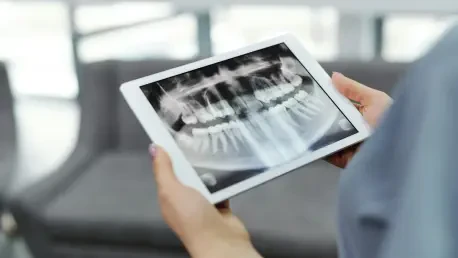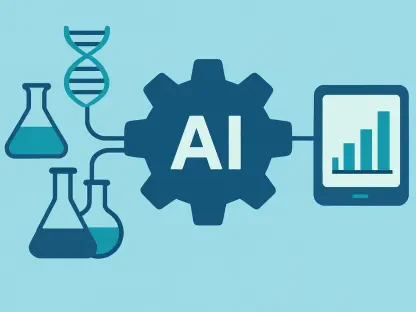The healthcare sector is witnessing a groundbreaking transformation driven by technological advancements in diagnostic imaging, marking a significant shift towards more precise and patient-centered care. These innovations allow for enhanced visualization of internal structures, facilitating early detection of diseases and minimizing the need for invasive procedures. From artificial intelligence (AI) to portable imaging devices, these technologies are playing a crucial role in optimizing diagnostic processes, ultimately leading to better treatment outcomes. The integration of these cutting-edge innovations not only improves operational efficiency but also brings healthcare services closer to patients, dramatically altering the landscape of modern medicine.
Artificial Intelligence in Diagnostic Imaging
AI-Powered Algorithms Enhance Accuracy
AI algorithms have revolutionized the realm of diagnostic imaging by providing clinicians with tools that enhance accuracy and efficiency. Leveraging machine learning, these algorithms can analyze complex medical images, discern patterns, and even predict disease progression with remarkable precision. This capability not only aids in early diagnosis but also reduces human error, offering a robust decision-support system for healthcare professionals. These AI systems are designed to learn continuously, improving over time as they integrate more data, thus marking a paradigm shift in how medical diagnostics are conducted.
The integration of AI into diagnostic imaging allows for automated interpretation, which is especially beneficial in understaffed facilities or in regions with limited access to specialized radiologists. By expediting the image analysis process, AI not only shortens patient wait times but also allows doctors to manage larger caseloads more effectively. This has led to improved patient outcomes, as timely diagnosis and treatment can significantly impact recovery rates. Moreover, AI is adaptable, making it suitable for a variety of imaging modalities, including MRI, CT, and X-ray, thereby offering a versatile tool in the modern healthcare arsenal.
Streamlining Workflow with AI-Driven Solutions
The implementation of AI in diagnostic imaging extends beyond accuracy, encompassing streamlined workflows for healthcare facilities. Automated image processing and analysis allow radiologists and technicians to focus on complex cases requiring human expertise. By delegating routine tasks to AI, healthcare providers can enhance productivity and allocate resources more efficiently, ultimately reducing costs while maintaining high-quality care.
Furthermore, AI’s ability to standardize imaging protocols ensures consistency across different healthcare settings, which is particularly advantageous when integrating data from multiple sources. This consistency simplifies reviewing and sharing patient information, facilitating collaboration among healthcare professionals. Continual advancements in AI technology promise further improvements in diagnostic imaging, supporting the healthcare sector’s shift toward a more holistic, data-driven approach to patient care.
Portable Imaging Devices and Enhanced Accessibility
Expanding Access Through Portability
The rise of portable imaging devices is reshaping diagnostic practices by bringing imaging capabilities directly to the patient, regardless of their location. Innovations in miniaturization and mobility have led to the development of lightweight, user-friendly scanners that facilitate on-the-spot diagnoses. This portability is especially crucial in remote or underserved areas where access to traditional imaging centers may be limited. By delivering real-time results in various settings, portable imaging technologies ensure that patients receive timely and effective care, which is essential for successful treatment outcomes.
These portable devices also empower healthcare providers by offering flexibility in managing their patients’ imaging needs. The ability to conduct diagnostic tests at the bedside or in other non-traditional settings makes it easier to monitor acute conditions and track treatment responses. Connectivity features enable seamless integration with electronic health records, ensuring that critical patient data is readily accessible. This adaptability addresses the increasing demand for diagnostics that align with the dynamic nature of healthcare delivery, thereby elevating the standard of care.
User-Friendly Designs Cater to Diverse Skills
With care settings expanding beyond hospital walls due to shifting patient volumes and care philosophies, device designs have evolved to accommodate users with varying expertise levels. Modern portable imaging solutions emphasize user-friendly interfaces, making them accessible to medical personnel with different backgrounds. This democratization of imaging technology is crucial for training purposes and for maintaining diagnostic quality across diverse healthcare environments. Tools equipped with intuitive controls and advanced features ensure that even users with minimal training can perform scans efficiently, fostering wider adoption and reducing the learning curve.
The practicality of these devices also extends to patient interactions, with designs focused on comfort and minimal invasiveness. As healthcare continues to prioritize patient-centric approaches, these considerations are vital in reducing anxiety associated with diagnostic procedures. By enhancing user and patient experiences, portable devices are integral in advancing diagnostic imaging’s reach and impact in contemporary healthcare settings. Through continuous innovation and integration, these technologies are progressively shaping the future of medical diagnostics.
Shifting Procurement Strategies in Diagnostic Imaging
Demand for Value-Based Procurement
In recent years, a noticeable shift has occurred in how healthcare providers approach equipment procurement, particularly emphasizing value-based models. This paradigm shift involves procuring equipment that meets both clinical and operational objectives, with suppliers held accountable for performance outcomes. Providers are increasingly demanding technology that not only delivers precision and reliability but also integrates seamlessly into existing healthcare workflows. This transformation reflects a more strategic approach to equipment investment, focusing on long-term benefits and operational sustainability.
Suppliers, in turn, are compelled to innovate and validate their technologies’ contributions post-purchase, ensuring that their products continue to provide value throughout their lifecycle. This demand for accountability encourages ongoing collaboration between providers and suppliers, fostering innovation tailored to real-world healthcare needs. As a result, the diagnostic imaging market is evolving to prioritize solutions that offer tangible value, aligning with the broader healthcare industry’s objectives of cost-effectiveness and quality improvement.
Innovative Approaches and Accountability
The emphasis on value-based procurement has spurred innovative approaches among suppliers, with an increased focus on outcome-based solutions. Companies are investing in the development of advanced diagnostic tools that are not only effective but can also adapt to changing healthcare demands. This focus on innovation ensures that equipment remains relevant and beneficial over time, meeting diverse clinical needs while supporting operational goals.
Furthermore, the integration of value-based procurement strategies incentivizes suppliers to maintain a high standard of customer support and service. Ensuring consistent performance and regular upgrades strengthens supplier-client relationships, creating a collaborative ecosystem where both parties benefit. This shift underscores the importance of strategic, long-term planning in healthcare investments, promising sustainable advancements in diagnostic imaging that enhance patient outcomes and streamline care delivery processes.
Moving Forward in Diagnostic Imaging
The healthcare industry is undergoing a remarkable transformation due to the rapid advancement of technology in the field of diagnostic imaging. This evolution signifies a pivotal move towards more accurate and patient-focused medical care. With these innovations, medical professionals gain an improved view of the body’s internal structures, which is crucial for the early detection of diseases. Moreover, it reduces the necessity for invasive procedures, offering a less intrusive alternative for diagnosing. Technologies such as artificial intelligence (AI) and portable imaging devices are at the forefront of this change, significantly enhancing the efficiency of diagnostic processes. This improvement inevitably leads to more effective treatment outcomes, benefiting patients in the long run. By integrating these state-of-the-art technologies, healthcare providers not only boost their operational effectiveness but also make healthcare services more accessible to patients. As a result, the landscape of modern medicine is being profoundly reshaped, bringing medical expertise and services closer to those who need them most.









